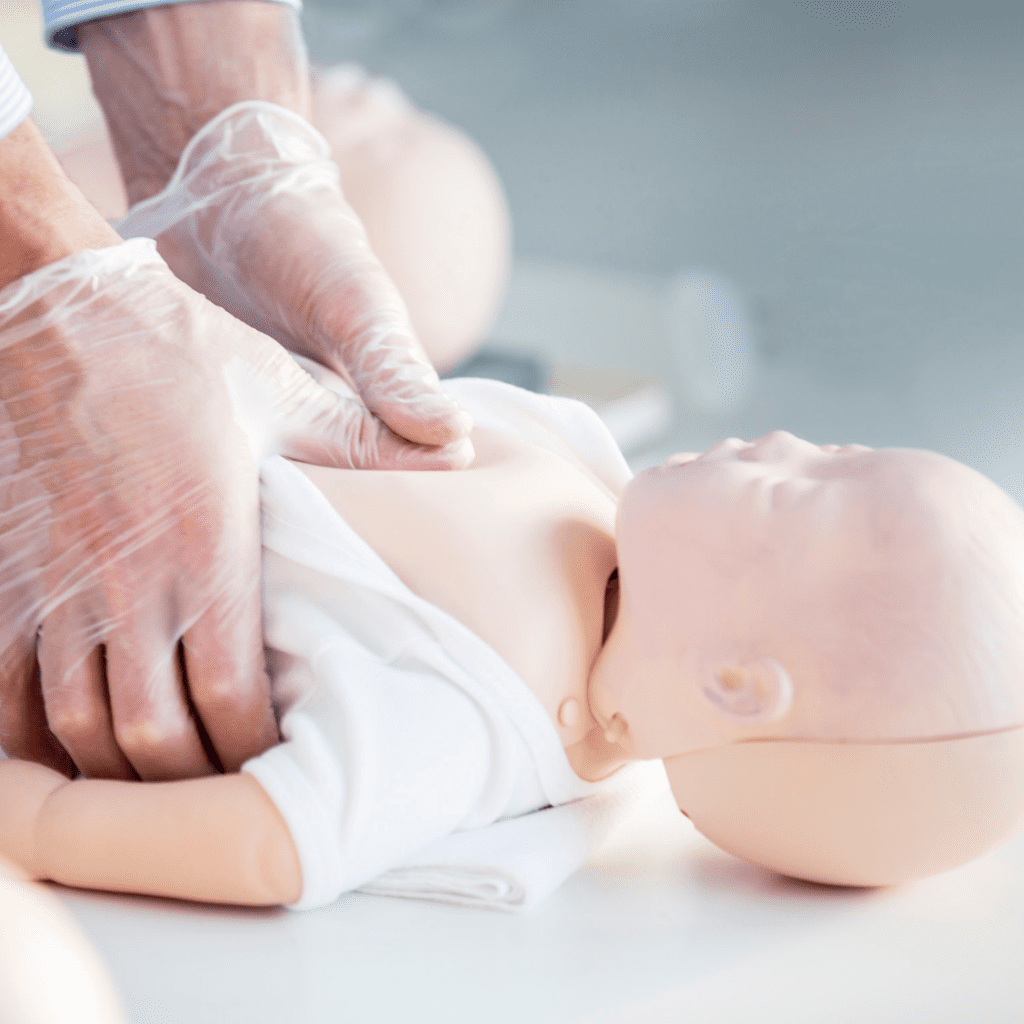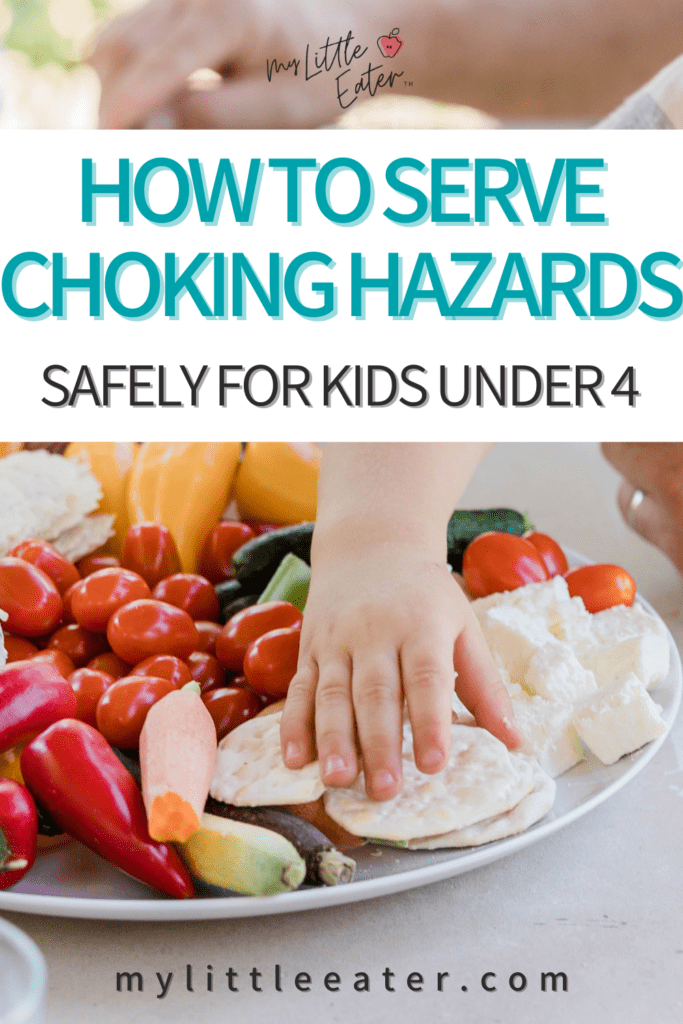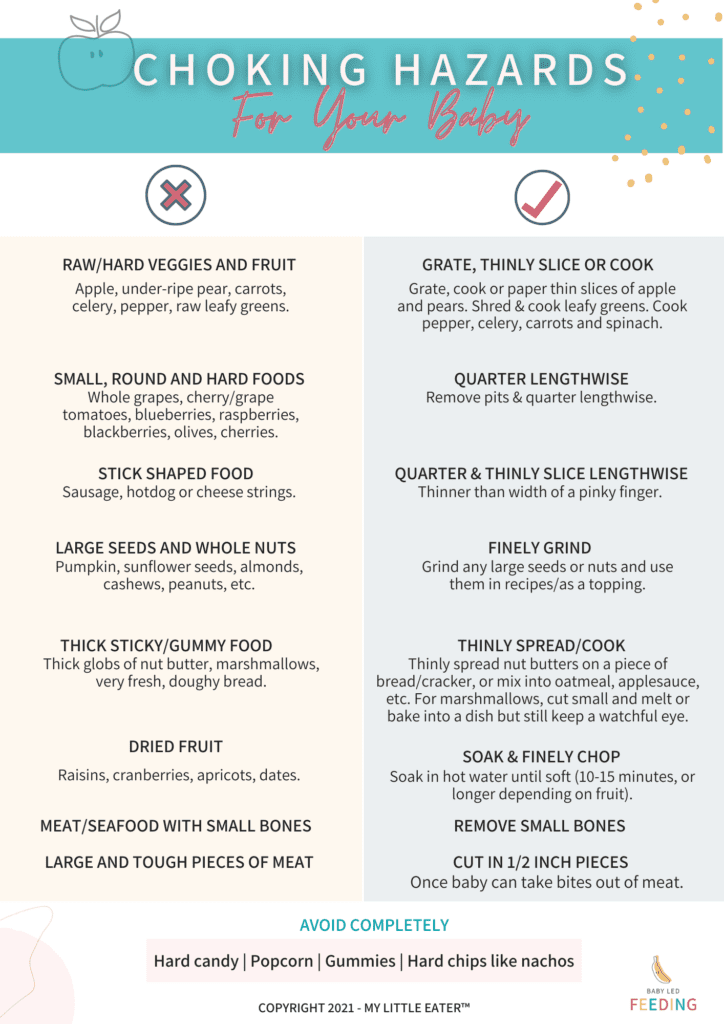This blog has been contributed to and reviewed by Holly Choi of @safebeginnings. Holly is a baby and toddler safety expert and mom of 2! You can learn more about her and her work, here.
This blog also contains affiliate links, please read our disclosure policy for more details.
It’s probably one of the most terrifying experiences that any parent can think of…and that’s their child choking on something. The fear and helplessness that comes from watching your child struggle isn’t anything we would wish on anyone.
And that’s why we find that choking is one of the most common questions that parents ask first when beginning to research starting solids with their baby. Whether they’re choosing to start with baby led weaning or purees, choking (and often gagging) are top of their list of concerns.
We also find that this worry lingers well into toddlerhood as parents start to wonder how long they need to be concerned about certain foods. And basically, they wonder whether or not they still need to take extra precautions when serving these foods to their 1, 2, or 3 year old.
Let’s get into the details including every food you need to be aware of, what modifications are considered safe, and what foods need to be completely avoided until age 4.

If you’re getting ready to start introducing solid foods to your baby, regardless of how they will be eating solid foods (spoon feeding purees or self feeding finger foods) we highly recommend taking an infant CPR and first aid course before baby’s first bite.
That’s why we’ve teamed up with Safe Beginnings, the creators of the best, most well-rounded baby CPR and injury prevention online course, to bring you the Baby Beginnings Bundle. With this bundle you’ll be getting both the Safe Beginnings infant CPR course so you can be prepared should the worst happen, and our Baby Led Feeding online course to learn exactly how to serve every food safely to minimize the risk to your baby when eating solids.

Table of Contents
Baby led weaning (BLW) choking concerns
Let’s get the most obvious question out of the way first.
Does starting solids with finger food options increase choking risk?

No.
Choking hazards are the same for all kids, regardless of whether you’re doing puree feeding or baby led weaning!
Research has shown that when parents are properly educated on how to safely serve finger foods to their babies, there is no increased risk for choking compared to traditional puree feeding (1). Babies, toddlers, and even adults can choke on anything at any time. Knowing how to set up the feeding environment and how to properly prepare foods are key to lowering your baby’s risk of choking.
Aren't larger pieces of food more of a risk than bite-sized pieces?

Most baby led weaning experts will tell you that you should start baby off with large, finger-shaped pieces of soft food that pass -what we call – the squish test. And most of the time parents are very concerned about these bigger pieces of food being in their baby’s mouth and would rather serve small bite-sized pieces.
You’ll learn more about this in the modification section, but essentially, bite-sized pieces of a certain shape, slipperiness, or texture can be more of a risk because they’re the perfect size for blocking your baby’s airway. It’s also easier to lose track of a small piece of food in the mouth, risking swallowing it whole without biting down on it to smush it first. On the other hand, large pieces of food are harder to lose track of and are more likely to trigger baby’s gag reflex (which is good because it’s a protective mechanism to prevent choking). It’s also easier for baby to spit out large pieces of food if needed.
So generally, larger pieces (when prepared safely) can often be safer for your baby. Now let’s learn about serving purees because while the choking risk is extremely minimal, it isn’t non-existent.
How do babies choke on pureed food?

This is something that parents wonder about all the time. They usually understand that the risk doesn’t increase with baby led weaning (provided they’re educated on safe practices), but what they struggle with is the idea that babies can choke on purees.
We reached out to Holly Choi of Safe Beginnings, a baby and toddler safety expert, to help us explain the mechanism of choking on purees.
Food, in this case purees, becomes trapped in the larynx and blocks the opening, preventing any air from passing through to the lungs. This is more common with respect to purees when babies are seated in reclined positions (since they can’t hold themselves up).
First, when food (including purees) falls to the back of the throat and touches the larynx, it triggers different reflexes to bring the food forward and out of the mouth – this includes coughing, gagging, and sometimes vomiting. Coughing is more productive when a baby is in an upright position (2), and being able to cough the puree back up will help to ensure that aspiration of the puree/liquid/solid food is not a concern. This is why we don’t recommend high chairs in reclined positions for feeding.

Second, when a baby (or anyone) is actively eating, the epiglottis (the dangling “flap” at the back of the throat) will block the windpipe and prevent choking (based on signals it receives from nerves associated with swallowing movements) (3). However, if your baby is too young to have a coordinated swallow pattern, and the development of the tongue movements required to initiate the reaction of a swallow is immature, the epiglottis may not react in time (3). This also happens when a baby is too tired to actively participate in feeding and cannot consciously decide to move purees around and swallow.
This is true even with very thin purees that may seem easy to swallow to us as adults. They still can feel different on the tongue to babies (who are experiencing this for the first time!) and they do need proper mature swallow patterns and tongue movements in order to move them around in their mouth (it’s not a simple in and out suckle motion like nursing or bottles) (4).
Now, I’m not trying to freak you out! Purees are still a minimal choking risk. However, I also don’t want parents to underestimate the severity of choking on purees and therefore be a bit looser with safety recommendations.
We still want baby to be fed in an upright position, we want them to be developmentally ready for solids, and we don’t want them to be fed in bouncers or jumpers or in any manner that increases their risk, such as when they’re too tired to actively participate in feeding. We’ll go over the specifics of setting up a safe feeding environment for your baby later on. First, let’s talk about the foods to be aware of.
Choking hazards for babies and toddlers under 4
The biggest thing to think about when determining if something is a choking hazard is: “Is this a texture that can easily get lodged in my baby/toddler’s airway when swallowed whole (or parts of it are broken off?).”
Solid foods are especially dangerous if they’re small and round shaped, as this can more easily block off all air in the airway if swallowed whole. This is especially risky for hard foods because they’re more difficult for babies and toddlers to break down due to limited chewing skills.
A baby’s airway is about the size of your pinky finger or the size of the opening of a typical drinking straw. You can use that as a guide to determine if it needs to be modified in shape, or avoided altogether.

Did you know that I wasn’t familiar with every choking hazard when I had my first son? I thought I was! But it was only when my son was almost two that I realized that thick peanut butter eaten off of a spoon was a choking hazard!! Maybe you didn’t know this either?
I’m willing to bet there are a few on this list that may be news to you, and of course, there will be others that are incredibly obvious. I’m going to break them down by category for you first, so you can see the full list, and then we can get into safety modifications.
Type 1: Solid foods that aren't easily squishable or dissolve easily with saliva

This category includes a wide variety of foods, some are modifiable and some need to be avoided completely.
Examples of foods in this category:
- Raw, hard veggies and fruit, like raw apple, raw under-ripe pear, raw carrots, raw celery
- Raw, leafy greens (you need your back molars to be able to chew these well)
- Hard candy
- Whole cherry tomatoes
- Whole grapes
- Whole blueberries
- Anything with a small pit still in it (e.g. olives, cherries)
- Dried fruit (like raisins, dried apricots, etc.)
- Whole nuts and seeds (like peanuts or cashews, and sunflower or pumpkin seeds)
- Large/very tough pieces of meat (e.g. steak)
This section would also include things like small bones in fish or meat, which are commonly removed already as they’re potential choking hazards for adults too.
Type 2: Foods that are stick-shaped

This can include some finger foods that your baby or toddler may be able to chew properly and manage easily, provided they’ve been modified. It’s when you serve them in a stick shape that these become high-risk choking foods. Again, if swallowed before they’re completely chewed, they can block the airway in its entirety.
This includes things like:
- Hot dogs
- Meat sticks (eg. pepperoni sticks)
- Sausages
- Cheese sticks/strings
Type 3: Foods that are gummy, chewy, or sticky making them hard to swallow

These are foods that can glob up in your baby’s mouth and can get more difficult to manage the more of it there is.
This includes things like:
- Gummies
- Marshmallows
- Chewing gum
- Jelly beans
- Thick globs of peanut butter or other nut butter
- Soft, fresh bread (for babies <1 year) (very fresh bread can gum up in the mouth and be hard to chew through)
Type 4: Foods that break into really jagged pieces

The trouble with these foods is that they are typically hard if they break apart like this, and the irregular shape created when they crumble makes it easy for them to become lodged in the airway. These are also foods that are incredibly dangerous if aspirated. Generally, the pieces that break off are small enough to travel to the lungs should they make it into the windpipe.
Examples include:
- Hard chips like nachos, potato or corn chips, and pretzels
- Popcorn
- And even super dry crackers should be avoided under 12 months of age (get my cracker guide for a complete list of crackers that are safe for each age group and are the most nutritious)
Since there are so many choking hazards to be aware of, I’ve made you an easy-to-view list! Click on the image to download the list and print it off for easy reference! Pop it on your fridge, and offer it to caregivers, grandparents, the daycare, or anyone else who may be feeding your baby or toddler.
Modifications to make a choking hazard safer
Ok…so does this mean you can never give your baby or toddler things like apples, carrots, tomatoes, etc. ever??
Definitely not!
There are ways to modify certain foods to make them safer. Let’s take a look at some examples to limit the chance your baby or toddler experiences a choking episode.

Modifying type 1 choking hazards
Foods like apples, pears, and carrots can be modified in a few different ways...
- Grate them and offer in a pile (or “haystack”) to have baby eat them.
- You can also very thinly slice apples and pears so that they aren’t in a thick wedge or sliced form which can result in hard, small or large chunks being easily broken off.
- Poach or steam them. They can be sliced and cooked in a pan, or in a microwave, with water or butter to soften them up. Add some cinnamon to apples and pears for more flavor and spice exposure too!
- Cook foods like raw peppers or raw carrots so they’re softer. You can offer raw peppers around 18 months+ depending on chewing ability.
For foods like nuts and seeds...
- Grinding them is the safest option, or very finely chop them, but still keep a watchful eye.
For leafy greens...
- Thinly shred or cook them so they aren’t as hard to chew.
For dried fruits, like dates, raisins, apricots, etc...
- Soak them in water for 5-10 minutes before offering them.
For hard, round foods...

I think we’ve all heard about grapes and how they are one of the most dangerous foods for babies and kids under 4 years old because of the way they perfectly conform to your child’s windpipe. These, plus foods like cherry tomatoes and blueberries, must be modified to limit choking, and should not be offered in their whole form until over 4 years old when chewing is well-established.
Even then, you’ll want to make sure that they take small, baby bites out of them, that your child’s mouth isn’t stuffed full with multiple, and that they’re seated while eating them. This is because they can so easily slide down your child or baby’s throat, past their gag reflex, and become lodged in their airway.
Until 4 years old, here’s how to serve them:
- Cut larger grapes, cherry tomatoes, and blueberries into quarters (or smaller if the pieces still seem larger than their airway).
- Move to cutting them in half after 18 months when proper chewing is more developed.
- You can also smush blueberries to serve them flat as an alternative to cutting them. This works really well for smaller, wild blueberries.
For tough pieces of meat...
- Cut large pieces of meat, like steak, into 1-2” pieces.
For hard candy...
- Foods like jolly ranchers or life savers cannot be safely modified and need to be avoided completely until age 4.
Modifying Type 2 Choking Hazards:

These can all be modified in the same way…
- Thinly slice all stick-shaped food, like hot dogs and cheese sticks, lengthwise until they are thinner than the width of your pinky finger.
Modifying Type 3 Choking Hazards:

Depending on the food, you’ll have to try different modifications to make these options safe to serve.
- Thinly spread nut butters on a piece of toast or cracker before serving, or you can thin it out by mixing it into oatmeal, applesauce, or other puree-like textures.
- Offer marshmallows in small pieces only when melted into a dish (we recommend avoiding added sugar until age 2 as well).
- Lightly toast bread so that it’s not too chewy. This is only necessary until about 18 months provided baby is experienced with chewing this texture.
- Foods like gummies and chewing gum cannot be modified and must be avoided until age 4.
Modifying Type 4 Choking Hazards:
All of the foods in this category cannot be safely modified and therefore should be avoided completely until your child is 4 years old and has the chewing skills to eat these safely.
Let's talk about survivorship bias

What is it? Well, my friend Holly at Safe Beginnings refers to this anytime someone says… “I did [insert risky behaviour here] and my baby is just fine!”. Essentially, they’re using the fact that they went against a specific safety recommendation and their child turned out fine, to suggest that the recommendation is not necessary.
Let’s first keep in mind that all kids are different, and have different chewing and eating abilities. Some babies are more equipped than others to be able to handle things like raisins without soaking them or they can eat raw apples whole by taking calculated bites out of them, and so on. But some babies are not and that’s exactly why these recommendations are in place.
You know your child best, and you know what risk you’re willing to take. Always remember that choking can happen on any type of food. The lists above are just the foods with the highest choking risk. If you feel like you are being vigilant, and your baby or toddler is able to handle eating something…well, that’s your decision to make! But generally, to be most careful, avoiding these foods or modifying them so that they’re safer, is always going to be recommended.
One more thing to add here is that if you’re dealing with family members or friends who are calling you overprotective or a helicopter parent for taking these precautions – please don’t listen! I’ll repeat, you know your baby best – not them! These decisions are for you to make, based on the information you know – be confident in what you decide. And just because they didn’t take these precautions with their children, doesn’t mean that you shouldn’t – that’s survivorship bias at work.
General precautions that lower the risk of choking with any food

As we’ve mentioned a few times now, choking can happen on literally any food. So being aware of other steps you can take to help lower that risk is really helpful as well. Let’s go through my top recommendations.
Assess readiness before starting solids
Make sure your child is developmentally ready to start solids, whether starting with purees or baby led weaning! This doesn’t mean that they’re just interested in food. They should be able to sit up unassisted which indicates that they have the core strength needed to hold themselves upright while eating and strapped into a highchair.
We don’t want to see babies leaning to the side while eating, positioned in a reclined manner, or falling forward in their chair because they’re unable to hold themselves up with minimal support around them. These types of positions increase their risk of choking because their airway is not straight and clear.
There’s no need to rush! Exclusive breastfeeding until 6 months of age is the current recommendation from all major regulatory bodies, including the American Academy of Pediatrics, Health Canada, and the Centers for Disease Control and Prevention.
Always supervise while eating

Your baby or toddler needs to be facing you while eating so that you can respond quickly should choking occur. Remember, choking is silent. You won’t hear them cry or react to choking in any manner, so you need to be able to see their face and notice the other signs. Read more about the signs of gagging vs. choking and how to tell them apart, here.
No eating and moving
This means no eating while walking around the room, riding in a car, or playing with friends. Sudden movements (or just movement in general) can cause food to slip to the back of the throat, past the gag reflex, resulting in a choking emergency. Always ensure baby eats sitting down, this is especially important (and often more difficult) as they get older and become more mobile. Create expectations early on to avoid pushback as they get older.
Learn more about our top recommendations for food to pack when traveling, and safety tips for feeding solids on the go!
Model safe eating habits
Babies and toddlers learn through imitation and observation – they are always watching you. Make sure that what you are showing them is safe eating habits. Sit down while eating, don’t overstuff your mouth, and always chew food thoroughly.
Educate caregivers

Anyone who may be caring for your child – this includes babysitters, daycares, grandparents, etc. – need to be aware of what the common choking hazards are and how to modify them. So give them the free cheat sheet above! Make sure they’re also aware of the other precautions mentioned above, and be sure to identify emergency resources and contacts for them before leaving your child with them.
In the Baby Led Feeding online course we have a complete caregiver guide for you to print off and pass on to anyone watching your child while you’re away.
Take an infant CPR course before having baby self-feed or start purees

This is arguably the most important step when getting ready to serve baby foods for the first time. Spoon fed babies and babies doing baby led weaning can both choke, as mentioned above. So no one is exempt from this step!
That’s exactly why we teamed up with Safe Beginnings, the creators of the most thorough online course for Infant CPR & Injury Prevention to bring you the Baby Beginnings Bundle. Get both the CPR course and our Baby Led Feeding course, at a discount, so you can have all the education you need to adequately decrease choking risk, and potentially save your baby’s life should the worst case scenario happen.
If you have ever seen a choking baby, or if you’ve ever had to perform CPR on anyone, you know just how terrifying those scenarios are. You have to be able to act fast and perform the procedure properly – you have time to help them, provided you have the knowledge to do so. You might not have the time to Google what to do though, so you really need to have the knowledge before anything happens.
Learn everything you need to know to keep your baby safe and prevent choking with the Baby Beginnings Bundle.

FIND THIS HELPFUL? PIN IT TO SAVE FOR LATER!

References:
- Daniels, L., Heath, A. L. M., Williams, S. M., Cameron, S. L., Fleming, E. A., Taylor, B. J., … & Taylor, R. W. Baby-Led Introduction to SolidS (BLISS) study: a randomised controlled trial of a baby-led approach to complementary feeding. BMC pediatrics, 15(1), 1-15, 2015.
- Matsuo K, Palmer JB. Coordination of Mastication, Swallowing and Breathing. Jpn Dent Sci Rev. 2009 May 1;45(1):31-40. doi: 10.1016/j.jdsr.2009.03.004. PMID: 20161022; PMCID: PMC2749282.
- Matsuo K, Palmer JB. Anatomy and physiology of feeding and swallowing: normal and abnormal. Phys Med Rehabil Clin N Am. 2008 Nov;19(4):691-707, vii. doi: 10.1016/j.pmr.2008.06.001. PMID: 18940636; PMCID: PMC2597750.
- https://www.nature.com/gimo/contents/pt1/full/gimo17.html#relatedcontent

ABOUT THE AUTHOR
EDWENA KENNEDY, RD
Founder and lead Registered Pediatric Dietitian at My Little Eater Inc., creator of The Texture Timeline™, and mom of two picky-turned-adventurous eaters.

ABOUT THE AUTHOR
EDWENA KENNEDY, RD
Founder and lead Registered Pediatric Dietitian at My Little Eater Inc., creator of The Texture Timeline™, and mom of two picky-turned-adventurous eaters.









